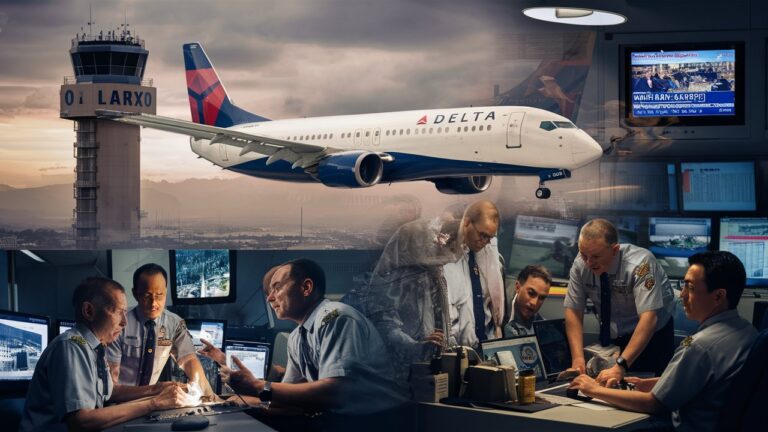Introduction
What should have been a routine trans-Pacific flight took an unexpected turn when Delta Flight DL275 was forced to divert and land at Los Angeles International Airport (LAX). Originally bound for Tokyo’s Haneda Airport, the Airbus A350 operating DL 275 encountered a critical technical issue mid-flight—an engine anti-ice system failure in one of its Rolls-Royce Trent XWB engines. This forced the aircraft to make a precautionary stop at LAX, a major Delta hub equipped with the necessary maintenance and medical infrastructure. The diversion underscores aviation’s unwavering commitment to safety—even when it disrupts international travel plans.
The Technical Trigger: Engine Anti-Ice System Failure
Midway over the North Pacific, approximately 620 nautical miles southwest of Anchorage, pilots detected an issue with the engine anti-ice system on the aircraft. This system uses heated bleed air to prevent ice formation on critical engine parts, such as fan blades and inlet guide vanes, which is especially vital at high altitude during cold conditions. A failure in this system cannot be ignored, as ice buildup may impair engine performance or lead to degradation of thrust. Given this seriousness, the crew chose to divert to LAX where expert technical support and facilities could address the malfunction promptly.thetipsygypsies.netCoruzant Technologies
Why LAX Was the Optimal Diversion Airport
Choosing a diversion point during such emergencies involves a careful balance of proximity, facilities, aircraft compatibility, and passenger welfare. LAX fits the bill on all fronts—its long runways are suitable for wide-body aircraft like the A350, and it maintains comprehensive maintenance capabilities, including Rolls-Royce engine specialists available 24/7. Passenger connections, medical assistance, and re-accommodation processes are also efficient there. This infrastructure makes it a logical and safe choice for the diversion.Coruzant TechnologiesAero Online
Passenger Experience & Crew Management
Passengers on board Delta Flight DL275 experienced a sudden shift from routine to uncertainty. However, flight attendants and crew acted with professionalism—providing calm updates, reassurance, and transparent communication, emphasizing safety above all. Passengers later described the calm atmosphere and clarity in announcements as pivotal in easing tension. Many took to social media to share relief and gratitude for the crew’s presence of mind.Vogue Vocalbishopwcmartin.com
Post-Diversion Protocols & Aircraft Inspection
Upon safely landing on LAX’s Runway 06R approximately 5.5 hours after the diversion decision, ground crews initiated immediate inspections. Technicians confirmed and assessed the engine anti-ice system failure, organizing necessary maintenance. Simultaneously, airline staff arranged onward travel options for passengers, rebooked tickets, and provided accommodations for delays as needed.Aero Onlinegetlistedae.com
Safety Culture: Diversion as a Success Story, Not a Failure
Despite its disruption, the diversion of DL275 serves as a powerful example of aviation safety protocols functioning as intended. Diversions are often viewed negatively, but experts recognize them as critical safety safeguards—protecting lives by allowing pilots to respond proactively to technical anomalies rather than waiting for them to escalate.thetipsygypsies.netCordless.io
Conclusion
The diversion of Delta Flight DL275 to LAX was not an unusual disruption—it was a clear demonstration of aviation safety in action. When faced with the failure of an engine anti-ice system during a trans-Pacific flight, the crew’s decision to reroute to a well-equipped airport prioritized passenger safety and technical readiness over schedules. While travelers may remember delays and inconvenience, the swift, composed, and decisive response from the airline and crew ensured that everyone arrived safely. This incident stands as a poignant reminder: in aviation, being grounded is often the highest form of flying well.
Frequently Asked Questions (FAQ)
Q1: Why was Delta Flight DL275 diverted to LAX?
It was diverted due to a serious engine anti-ice system failure—prompting precautionary landing at LAX, which has Delta’s robust support infrastructure.thetipsygypsies.netCoruzant Technologies
Q2: Was anyone injured during the diversion?
No injuries were reported. The aircraft landed safely, and passengers were managed professionally.Aero Online
Q3: How long did it take from the failure to landing?
The plane landed approximately 5.5 hours after the diversion decision was executed.Aero Online
Q4: Why choose LAX over closer options like Seattle or Anchorage?
LAX offers superior maintenance, medical, and rebooking facilities, making it safer even if slightly farther from the failure point.Coruzant TechnologiesCordless.io
Q5: How common are such diversions for long-haul flights?
Diversions happen more often than most travelers realize. They are precautionary measures to ensure safety, especially over remote routes like trans-Pacific flights.Cordless.io
